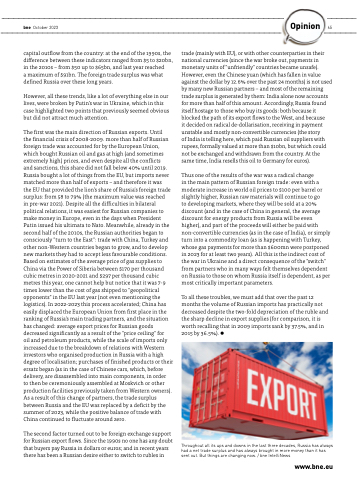Page 65 - bneMag Oct23
P. 65
bne October 2023
Opinion 65
capital outflow from the country: at the end of the 1990s, the difference between these indicators ranged from $5 to $20bn, in the 2010s – from $50 up to $65bn, and last year reached
a maximum of $91bn. The foreign trade surplus was what defined Russia over these long years.
However, all these trends, like a lot of everything else in our lives, were broken by Putin’s war in Ukraine, which in this case highlighted two points that previously seemed obvious but did not attract much attention.
The first was the main direction of Russian exports. Until
the financial crisis of 2008-2009. more than half of Russian foreign trade was accounted for by the European Union, which bought Russian oil and gas at high (and sometimes extremely high) prices, and even despite all the conflicts
and sanctions, this share did not fall below 40% until 2019. Russia bought a lot of things from the EU, but imports never matched more than half of exports – and therefore it was
the EU that provided the lion’s share of Russia’s foreign trade surplus: from 58 to 79% (the maximum value was reached
in pre-war 2021). Despite all the difficulties in bilateral political relations, it was easiest for Russian companies to make money in Europe, even in the days when President Putin issued his ultimata to Nato. Meanwhile, already in the second half of the 2010s, the Russian authorities began to consciously "turn to the East": trade with China, Turkey and other non-Western countries began to grow, and to develop new markets they had to accept less favourable conditions. Based on estimates of the average price of gas supplies to China via the Power of Siberia between $170 per thousand cubic metres in 2020-2021 and $297 per thousand cubic metres this year, one cannot help but notice that it was 7-9 times lower than the cost of gas shipped to "geopolitical opponents" in the EU last year (not even mentioning the logistics). In 2022-2023 this process accelerated; China has easily displaced the European Union from first place in the ranking of Russia’s main trading partners, and the situation has changed: average export prices for Russian goods decreased significantly as a result of the "price ceiling" for
oil and petroleum products, while the scale of imports only increased due to the breakdown of relations with Western investors who organised production in Russia with a high degree of localisation; purchases of finished products or their ersatz began (as in the case of Chinese cars, which, before delivery, are disassembled into main components, in order
to then be ceremoniously assembled at Moskvich or other production facilities previously taken from Western owners). As a result of this change of partners, the trade surplus between Russia and the EU was replaced by a deficit by the summer of 2023, while the positive balance of trade with China continued to fluctuate around zero.
The second factor turned out to be foreign exchange support for Russian export flows. Since the 1990s no one has any doubt that buyers pay Russia in dollars or euros; and in recent years there has been a Russian desire either to switch to rubles in
trade (mainly with EU), or with other counterparties in their national currencies (since the war broke out, payments in monetary units of "unfriendly" countries became unsafe). However, even the Chinese yuan (which has fallen in value against the dollar by 12.6% over the past 24 months) is not used by many new Russian partners – and most of the remaining trade surplus is generated by them: India alone now accounts for more than half of this amount. Accordingly, Russia found itself hostage to those who buy its goods: both because it blocked the path of its export flows to the West, and because
it decided on radical de-dollarisation, receiving in payment unstable and mostly non-convertible currencies (the story
of India is telling here, which paid Russian oil suppliers with rupees, formally valued at more than $10bn, but which could not be exchanged and withdrawn from the country. At the same time, India resells this oil to Germany for euros).
Thus one of the results of the war was a radical change
in the main pattern of Russian foreign trade: even with a moderate increase in world oil prices to $100 per barrel or slightly higher, Russian raw materials will continue to go
to developing markets, where they will be sold at a 20% discount (and in the case of China in general, the average discount for energy products from Russia will be even higher), and part of the proceeds will either be paid with non-convertible currencies (as in the case of India), or simply turn into a commodity loan (as is happening with Turkey, whose gas payments for more than $600mn were postponed in 2023 for at least two years). All this is the indirect cost of the war in Ukraine and a direct consequence of the "switch" from partners who in many ways felt themselves dependent on Russia to those on whom Russia itself is dependent, as per most critically important parameters.
To all these troubles, we must add that over the past 12 months the volume of Russian imports has practically not decreased despite the two-fold depreciation of the ruble and the sharp decline in export supplies (for comparison, it is worth recalling that in 2009 imports sank by 37.5%, and in 2015 by 36.5%).
Throughout all its ups and downs in the last three decades, Russia has always had a net trade surplus and has always brought in more money than it has sent out. But things are changing now. / bne IntelliNews
www.bne.eu


